-Overseas Project Satisfying Local Needs-
Hitachi markets its monorail systems internationally by drawing on more than 50 years of experience with monorails in Japan, as well as with overseas projects. Daegu Urban Railway Line 3 is in South Korea, the fourth country outside Japan to which Hitachi has supplied monorails. It has made a concerted effort to include locally made products, reducing production costs by having the production-model rolling stock manufactured by a Korean company. Based on the lessons learned from a fire that occurred in a subway train in South Korea, improvements to fire-extinguishers on trains and to evacuation equipment were adopted to help dispel passenger concerns about riding in monorails, which run on elevated tracks.

Rail Project Engineering Department, Railway Systems Business Unit, Hitachi, Ltd. He is currently engaged in the engineering and assembling of monorail systems. Mr. Kimijima is a member of The Japan Society of Mechanical Engineers (JSME).

Rail Project Department, Daegu Branch, Hitachi Korea, Ltd. He is currently engaged in the engineering and assembly of monorail systems.

Rolling Stock Systems, Design Department, Kasado Rail Systems Product Division, Railway Systems Business Unit, Hitachi, Ltd. He is currently engaged in the design of bogies for monorail rolling stock.

Signaling Systems Design Department, Mito Rail Systems Product Division, Railway Systems Business Unit, Hitachi, Ltd. He is currently engaged in engineering related to wayside equipment for overseas urban traffic signalling systems.
HITACHI has previously supplied monorail systems to three countries outside Japan. Each of these countries had different regulations, standards, and system scopes, so Hitachi built and supplied these systems in accordance with their needs and the respective regulations and standards, taking account of customer requirements and local circumstances as much as possible.
The monorail for Daegu Urban Railway Line 3 (hereafter Line 3) is in Daegu Metropolitan City in South Korea, making it the fourth country outside Japan to which Hitachi has supplied a monorail (see Fig. 1).
This article gives an overview of Line 3 and the products supplied for it, and describes Hitachi's strategy for future monorail systems for overseas.
Fig. 1—Route Map of Daegu Urban Railway. Lines 1 to 3 link major districts and provide comfortable transportation around the city.
Lines 1 to 3 link major districts and provide comfortable transportation around the city.
TABLE 1. Overview of Daegu Urban Railway Lines
The existing Lines 1 and 2 are subways (including some above-ground track).

Daegu is a city of about 2.5 million people (as of August 2016) located in the southeastern part of South Korea. Daegu Metropolitan Transit Corporation, the city's metro operator, has three lines in total, including the newly opened Line 3 (see Table 1).
Line 1, running from the northeast to the southwest of the city, opened in 1997, and Line 2, running from east to west, opened in 2005, both as subway lines. Subsequently, there were calls from the public and businesses for the construction of rail-based public transportation in the northwest and southeast areas of the city, which were not served by the metro.
This led to the decision in 2007 to construct Line 3, which was to run for 23.9 km (23.1 km of which was used for services) between the northwest and southeast of the city. The decision to make the line a saddle monorail was made in 2008, and it was further decided to use a Japanese design that was already used by a number of urban transportation services. Hitachi supplied the core products and systems used by the Line 3 monorail, namely, the rolling stock, track switches, and signalling systems. The line opened in April 2015.
The rolling stock for Line 3 are straddled monorail vehicles with a track beam width of 850 mm and maximum axle load of 11 t, and are of a type that Hitachi has previously supplied to numerous lines both in Japan and elsewhere (see Table 2).
The project involves the supply of 28 trainsets (84 vehicles) in total, with a three-car trainset configuration (see Fig. 2). The following sections describe the specific rolling stock equipment and functions supplied for Line 3, and other noteworthy aspects (see Fig. 3 and 4).
TABLE 2. Rolling Stock Specifications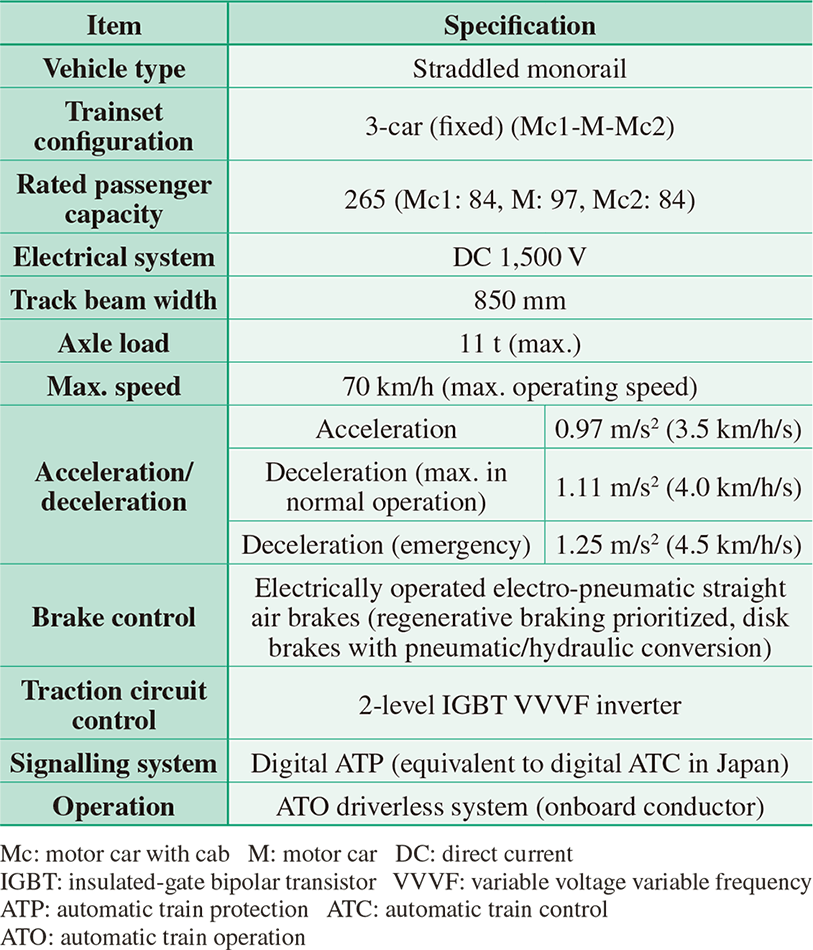 The rolling stock are saddle monorail vehicles with a rail width of 850 mm and a maximum axle load of 11 t, and are of a type that Hitachi has previously supplied for numerous lines both in Japan and elsewhere.
The rolling stock are saddle monorail vehicles with a rail width of 850 mm and a maximum axle load of 11 t, and are of a type that Hitachi has previously supplied for numerous lines both in Japan and elsewhere.
Fig. 2—Rolling Stock Dimensions. The trainsets have a fixed three-car configuration and are 46.2 m long (including the front-end coupling). Because operation is fully automatic, the cars do not have a driver’s cabin and the front-end includes viewing seats that allow passengers to enjoy the view through the windows.
The trainsets have a fixed three-car configuration and are 46.2 m long (including the front-end coupling). Because operation is fully automatic, the cars do not have a driver’s cabin and the front-end includes viewing seats that allow passengers to enjoy the view through the windows.
Rather than build all of the trainsets for Line 3 in Japan, only the prototypes were built at Hitachi's Kasado Works, and the production-model trainsets (numbers 2 to 28) were built by Woojin Industrial Systems, a local rolling stock manufacturer, with key machinery and components being supplied from Japan (see Fig. 5).
Fig. 5—Division of Responsibilities for Manufacturing Production-model Trainsets. The production-model trainsets were built using a knock-down assembly model whereby structural components and key equipment were exported from Japan to South Korea and the rolling stock was assembled at a local rolling stock manufacturer.
The production-model trainsets were built using a knock-down assembly model whereby structural components and key equipment were exported from Japan to South Korea and the rolling stock was assembled at a local rolling stock manufacturer.
Fig. 6—Onboard Fire-extinguishing Equipment. Water and compressed air tanks are located on the roof (left). When smoke is detected by the smoke detectors in the ceiling ducts, or the manual alarm (top right) is pressed in the passenger compartment, compressed air causes water to be sprayed out at high pressure from seven nozzles in the ceiling (bottom right).
Water and compressed air tanks are located on the roof (left). When smoke is detected by the smoke detectors in the ceiling ducts, or the manual alarm (top right) is pressed in the passenger compartment, compressed air causes water to be sprayed out at high pressure from seven nozzles in the ceiling (bottom right).
Learning from the experience of a major subway train fire that happened at the Jungangno Station on Daegu Urban Railway Line 1 in 2003, rolling stock for Line 3 will be fitted with not only conventional portable fire extinguishers but also a fire-extinguishing system with highly pressurized water that sprays a mist through ceiling nozzles to ensure that any fire is quickly extinguished (see Fig. 6).
Moreover, because the fire-extinguishing system uses ordinary tap water without any special additives and is pressurized by compressed air, it poses no risk to people or the surrounding environment.
Fig. 7—Passenger Evacuation Equipment. Spiral chutes are located in boxes (top left) behind the viewing seats in the front and rear cars, and are used by opening the lid of the box, taking off the cover, and removing them (bottom left). The frame is fixed to a side door and the chute is lowered to the ground (right) to allow passengers to evacuate the train.
Spiral chutes are located in boxes (top left) behind the viewing seats in the front and rear cars, and are used by opening the lid of the box, taking off the cover, and removing them (bottom left). The frame is fixed to a side door and the chute is lowered to the ground (right) to allow passengers to evacuate the train.
To enable passengers to evacuate the monorail vehicles safely and speedily in an emergency, two passenger evacuation systems are located behind the viewing seats in the front and rear cars (four systems in total) (see Fig. 7).
The systems were developed jointly by Tokyo Monorail Co., Ltd. and Hitachi and feature spiral chutes. The spiral design of the chutes limits the speed at which passengers descend to 3 m/s or less, ensuring that they can reach the ground safely.
Because of the high likelihood of snowfall in Daegu during winter, Hitachi supplied snow brushes that can be fitted to front-end cars to prevent the build-up of snow on the rail. Furthermore, some trainsets have been additionally fitted with piping that can be used to apply a thawing agent to the running surfaces of the rails to prevent them from icing up during cold or snowy weather.
This is the first time that Daegu Metropolitan Transit Corporation will operate a monorail that runs on elevated rails for its entire length. Accordingly, to enable it to deal appropriately with snowy conditions, operational and other measures based on how this is handled in Japan have been collated into an operating manual.
Article 36 of South Korea's railroad safety act and its associated ordinances, along with the country's standards for performance testing of urban rolling stock, include detailed stipulations for the production inspections and performance tests to be carried out when rolling stock are manufactured (see Table 3).
The inspections and tests must be attended by inspection and testing staff from government-designated agencies, who bear witness that these criteria have been met.
To satisfy these requirements, Hitachi established systems and processes for inspection and testing from an early stage in the project. Hitachi succeeded in passing all inspections and tests and delivered the rolling stock without causing any delays by immediately revising its processes and substituting different procedures whenever there was a risk of exceeding the scheduled number of inspection and testing days.
TABLE 3. Inspections and Tests Required for Rolling Stock in South Korea
Before rolling stock is allowed to be tested on the actual line, it must first undergo unit testing of materials, parts, equipment, and key components, testing of the completed vehicle, and then preliminary on-track testing to confirm that the rolling stock is ready to run on the actual line without problems.
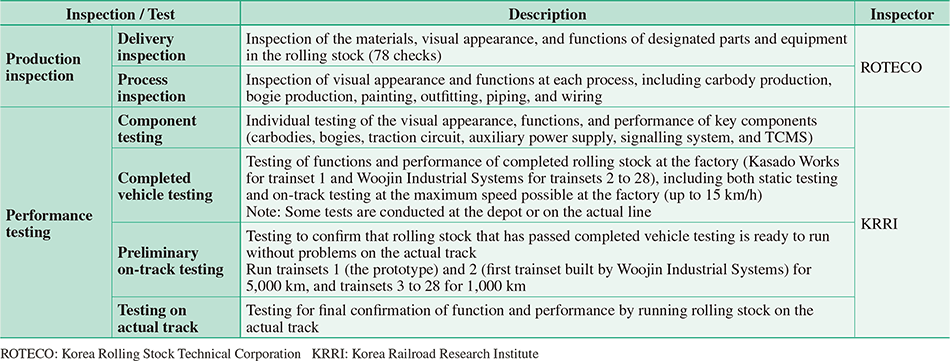
Line 3 uses digital automatic train protection (ATP) [equivalent to the digital automatic train control (ATC) used in Japan], whereby digital communications are used to exchange control signals between onboard and wayside systems.
Digital ATP is based on the onboard system. That is, it prevents the train from advancing past the end of the track, or entering sections of track that are occupied by another train or have been blocked, by having the onboard system generate a stopping pattern based on information about its own location and information about where to stop, which is sent from the wayside system. Furthermore, in the case of sections of track with speed limits, such as curves or gradients, it keeps the train speed within the limits by providing the onboard system with a deceleration pattern prior to entering the speed-limited section. Meanwhile, the digital ATP system also interoperates with the automatic train operation (ATO) system to maintain smooth automatic operation (see Fig. 8).
Fig. 8—Vehicle Speed Control by Digital ATP and ATO System.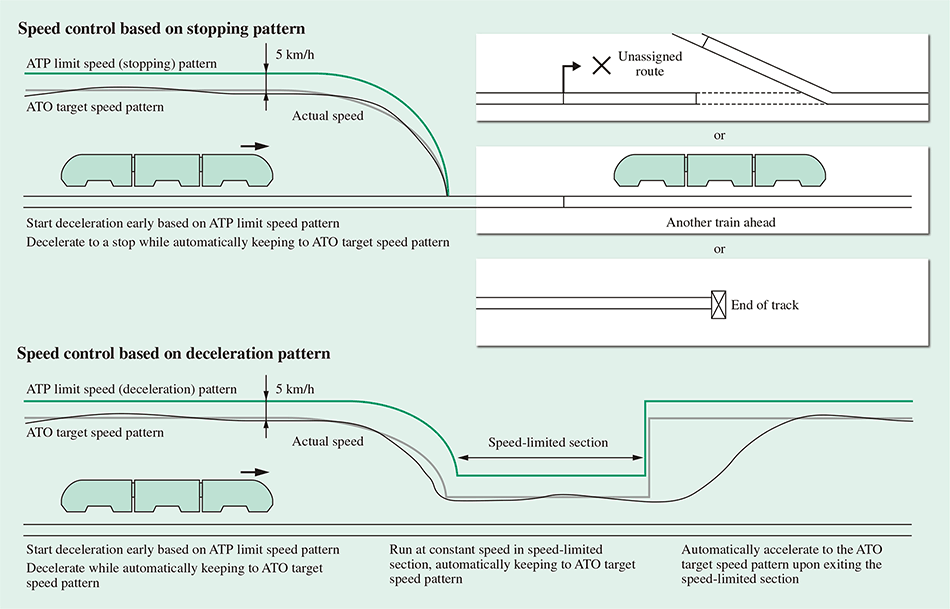 The use of digital communications enables high-volume, bi-directional transmission of data between the onboard and wayside systems to achieve precise automatic operation while also reliably maintaining train safety.
The use of digital communications enables high-volume, bi-directional transmission of data between the onboard and wayside systems to achieve precise automatic operation while also reliably maintaining train safety.
Line 3 operates fully automatically without any need for driver intervention (see Fig. 9). A traffic management system has been adopted that is able to control operation automatically based on the train diagrams (operating schedules), including the trip to and from the depot storage track as well as on the line itself.
Information about the trains on the line and video from the train surveillance cameras (showing each car interior and the view from the front and rear cars) are sent to the control room in realtime to provide the controllers (control center staff) with up-to-date train information.
Fig. 9—Flowchart of Automatic Operation.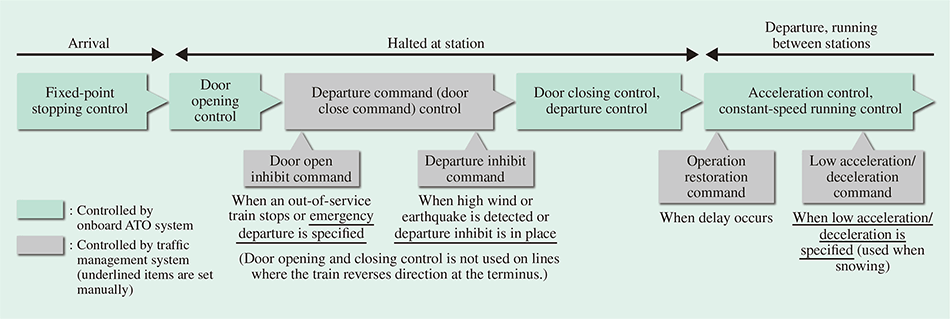 The system operates the trains on the line without any manual intervention, based on train diagrams (operating schedules) specified in advance. As well as on the line itself, trips to and from the depot storage track are also handled automatically, based on train diagrams.
The system operates the trains on the line without any manual intervention, based on train diagrams (operating schedules) specified in advance. As well as on the line itself, trips to and from the depot storage track are also handled automatically, based on train diagrams.
TABLE 4. List of Track Switches
Flexible-type track switches are used in locations where there is a need to increase the opposite side passing speed (curved passing side).
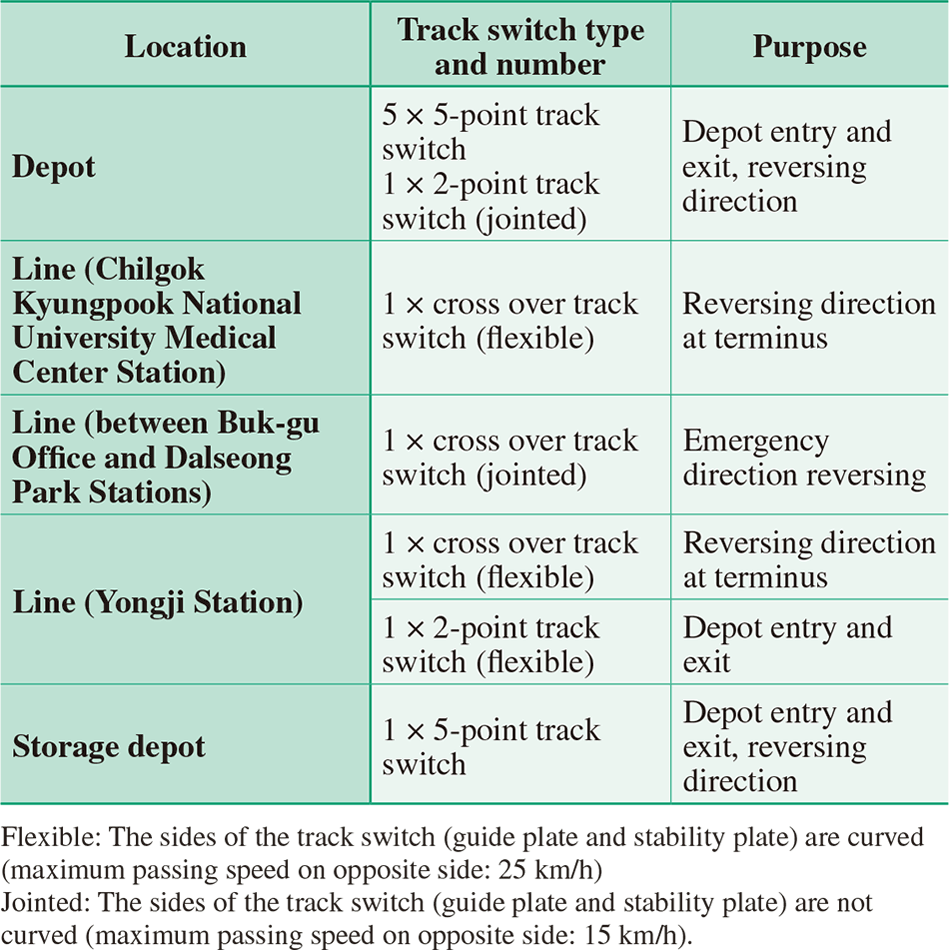
Track switches that have demonstrated their reliability in Japan and elsewhere were adopted for the Line 3 monorail, both on the line and in the depot (see Table 4).
To deal with weather conditions in Daegu, anti-icing heaters are installed in the lock grooves and control panel and operate when the temperature falls below a specified level to prevent operational disruptions caused by the icing up due to snowfall or low temperatures in winter.
Hitachi intends to undertake the following three development projects or organizational enhancements with the aim of utilizing past work and experience to supply further monorail systems outside Japan.
Making rolling stock lighter simplifies civil engineering structures because it reduces the load on the supporting rails, including in the case of monorails. Lightweight rolling stock also brings significant system-wide benefits, including requiring less energy to propel the rolling stock. Accordingly, Hitachi is engaged in ongoing work aimed at reducing weight, including that of monorail rolling stock, by simplifying equipment and revising its designs and installation practices. Particularly in the case of bogies and drive units that have designs specific to straddled monorails, Hitachi has been working on new development projects aimed at simplifying designs and reducing their weight. Because making designs simpler also makes maintenance easier, Hitachi is taking steps to achieve this soon by conducting performance assessments on prototypes.
Some overseas monorails are equipped with CBTC, which uses wireless communications for detecting train locations and transmitting rolling stock control information. CBTC has many benefits because it reduces on-site installation work by eliminating the need to install equipment in the field (such as loop coil cables and impedance matching circuits), as well as achieving shorter intervals between trains through the control of movement interlocks. Hitachi intends to work toward adopting it as its standard signalling system on monorail systems outside Japan.
Hitachi intends to improve its project management, system integration, and other system-wide coordination capabilities by strengthening its collaboration with Ansaldo STS S.p.A., an Italian railway engineering company that has become part of Hitachi, to make the most of the experience of both companies.
As the first commuter monorail system in South Korea, Line 3 has attracted attention from national and local government as well as from companies. The line has been well received both by those living along the line and by visitors to Daegu. It has also generated significant synergies, with businesses and tourist attractions along the line enjoying growing patronage as the number of people using Line 3 has increased.
In the future, rather than marketing monorail systems on their own, Hitachi intends to offer more advanced solutions that incorporate the needs of the customer and local circumstances.
In closing, the authors would like to express their gratitude for the considerable support provided by Japanese monorail operators during overseas projects.